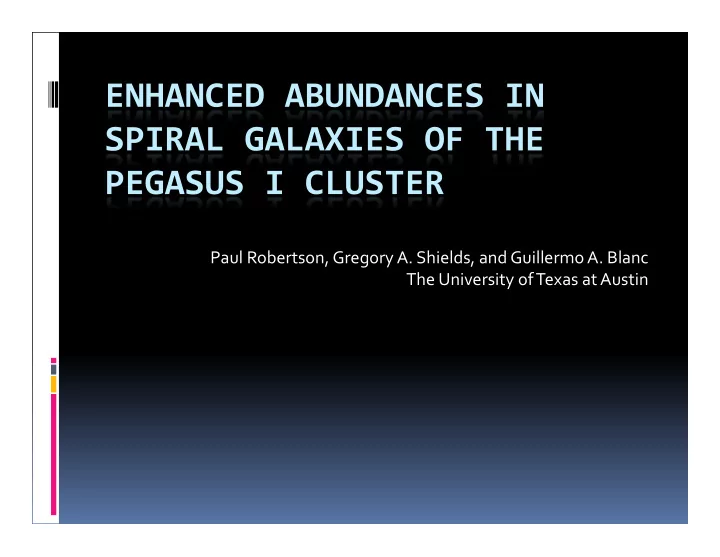

Paul Robertson, Gregory A. Shields, and Guillermo A. Blanc The University of Texas at Austin
Abstract The metallicity of the H I deficient spirals in the Pegasus cluster core is elevated by 0.14 dex, compared to a control sample of H I normal Pegasus spirals. H I deficient spirals in the Virgo cluster also show enhanced abundances, suggesting similar environmental mechanisms at work in both clusters.
Introduction Galaxies in clusters experience different phenomena from field galaxies . As a result, we see different morphologies, gas content, SF histories, etc. in clusters. This study examines galactic chemical abundances for cluster spirals.
Enhanced abundances in Virgo Skillman et al. 1996 Observation of high abundances for gas‐poor Virgo spirals (Skillman et al. 1996) first demonstrated this effect. Virgo: nearby, high density, Virgo H II Regions high gas deficiencies => ideal test bed. Key: Closed circles = H I‐deficient galaxies Result: gas‐deficient core Closed triangles = H I‐normal galaxies spirals more abundant by Open squares = Intermediate deficiency ~0.3 dex.
Enhanced abundances in Virgo Skillman et al. 1996
Enhanced abundances in cluster spirals SDSS galaxies (Cooper et al. 2008, Ellison et al. 2009) show higher characteristic metallicities when found in clusters & high‐ density environments. Zhang et al. (2009) demonstrate SDSS galaxies’ metallicity increases as gas content decreases. The Hercules cluster (Petropoulo et al. 2011) shows elevated abundances in dwarfs (unclear for spirals).
The Pegasus I Cluster Hypothesis: If Pegasus spirals show H I stripping from ICM‐ISM interactions, we expect to see higher nebular metallicity as well. Experiment: Use the VIRUS‐P integral‐field spectrograph on the McDonald Observatory 2.7‐meter telescope to measure H II region abundances for six Pegasus galaxies.
The Pegasus I Cluster Low density, low velocity dispersion cluster. Appears to be in earliest stages of collapse (Vigroux et al. 1989). Despite above points, Pegasus displays H I deficiency and suppressed star formation similar to, but less than, Virgo (Levy et al. 2007, Rose et al. 2010)! Levy et al. 2007
Galaxy Selection 3 face‐on, gas‐deficient spirals NGC 7643 3 face‐on, gas‐normal spirals NGC 7529
Gas‐Deficient Spirals Hα Narrow‐Band R Band NGC 7518 NGC 7643 UGC 164
Gas‐Normal Pegasus I Spirals Hα Narrow‐Band R Band NGC 7537 UGC 11524 UGC 11759
Nebular abundance in cluster spirals Observational signature: strong‐line [O II], [O III] emission Increasing abundance => more collisional cooling in fine structure lines => weaker [O II], [O III]! Decreasing ionization due to lower stellar T eff augments the phenomenon. McGaugh 1991
VIRUS‐P 246 4” diameter fibers Two grating settings provide wavelength coverage from ~3500‐7000 Å 3.5 arcmin 2 field of view
Results 9.4 4 IC 5309 NGC 7518 IC 5309 NGC 7643 9.3 NGC 7518 NGC 7529 NGC 7643 NGC 7591 NGC 7529 3 IC 1474 NGC 7591 9.2 12 + log(O/H) 9.1 f [OIII] /f H � 2 9 8.9 1 8.8 8.7 0 0 1 2 3 4 0 1 2 3 4 R/R e R/R e 12 + log(O/H) [O III] flux only Abundance gradients vary with H I deficiency!
Defining Galactic Metallicity Mean galactic metallicity defined as metallicity at some fiducial radius (see Zaritsky et al. 1994). 9.3 NGC 7643 NGC 7518 9.25 We define mean 9.2 IC 5309 Average 12 + log(O/H) NGC 7591 abundance as metallicity at 9.15 0.4 R iso , determined from 9.1 9.05 radial gradient. NGC 7529 9 8.95 Result: More deficient 8.9 -0.2 0 0.2 0.4 0.6 DEF galaxies are more abundant!
Comparison to Virgo/Field Pegasus Virgo H I Deficient Pegasus Spirals 9.2 H I Normal Pegasus Spirals Field Galaxies from Zaritsky et al. (1994) Mean (12 + log (O/H)), R = 0.4R 0 9 8.8 8.6 -16 -17 -18 -19 -20 -21 -22 M B
How much of an offset? H I‐deficient Pegasus spirals are, on average, ~0.15 dex more metal‐rich than the control sample, compared to 0.3 dex for Virgo. BUT, the Virgo control galaxies are much further from the cluster center than our controls—they’re basically field galaxies! As it turns out, this smaller offset is what we would expect.
How much of an offset? The “normal” galaxies in the Pegasus cluster are actually analogous 9.4 to the “intermediate” galaxies in the Skillman 9.3 et al. (1996) Virgo NGC 7643 NGC 7518 sample. Average 12 + log(O/H) 9.2 IC 5309 NGC 7591 Abundances at a given 9.1 gas deficiency level are similar for both clusters! NGC 7529 9 Pegasus Spirals Virgo Spirals 8.9 -0.4 -0.2 0 0.2 0.4 0.6 0.8 1 DEF
Comparison to field Normalize O/H to field galaxy O/H – M B trend (fit to Zaritsky et al 0.4 1994). Oxygen Abundance Differential (dex) 0.2 Trend clear for cluster galaxies but absent for 0 field galaxies. -0.2 Pegasus Spirals Virgo Spirals -0.4 Zaritsky et al. (1994) Field Sample -0.4 -0.2 0 0.2 0.4 0.6 0.8 DEF
Nebular abundance in cluster spirals ISM‐ICM interactions strip hydrogen gas from spirals as they fall through the cluster. Additionally, this process cuts off infall of primordial gas into the disk. Result: less dilution of heavy elements from SNe.
Conclusions Like Virgo and other high‐density environments, spiral galaxies in the Pegasus cluster that have experienced H I loss show proportionally higher heavy element content. While the observed abundance increase is of a modest nature, it is what we expect for the range of H I deficiency considered. This metallicity offset may be caused primarily by infall cutoff (Skillman et al. 1996), but second‐order effects related to H I disk truncation (Shields et al. 1991) may also occur.
Recommend
More recommend